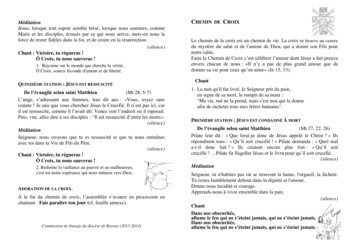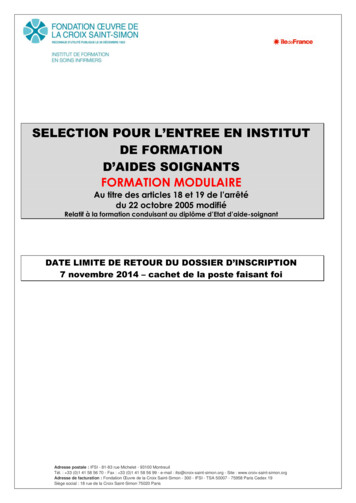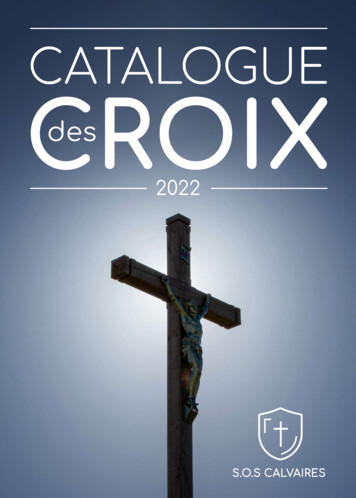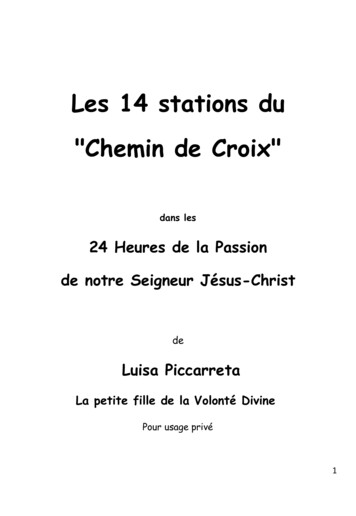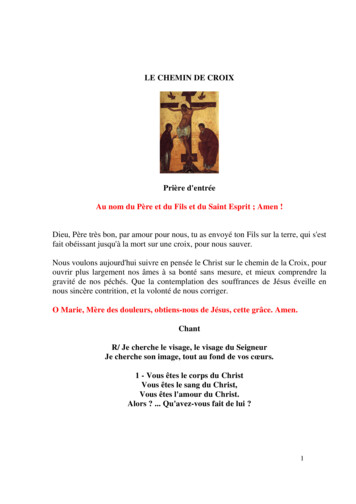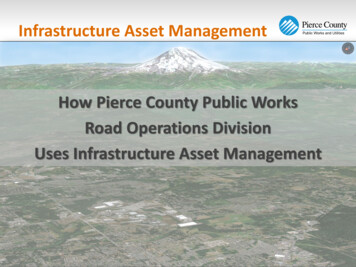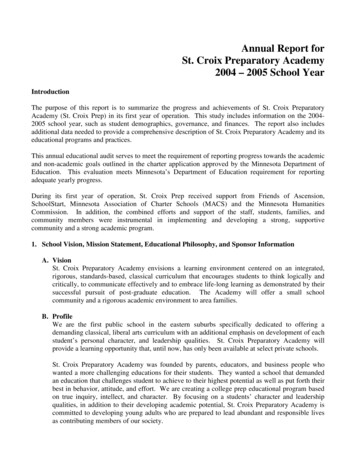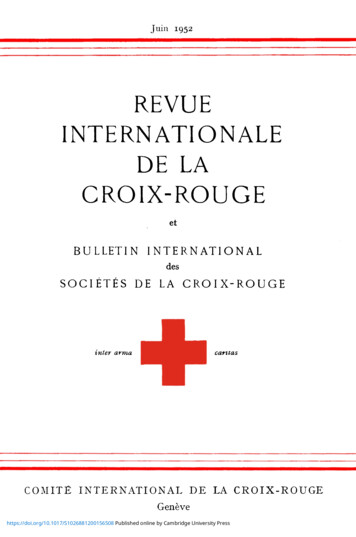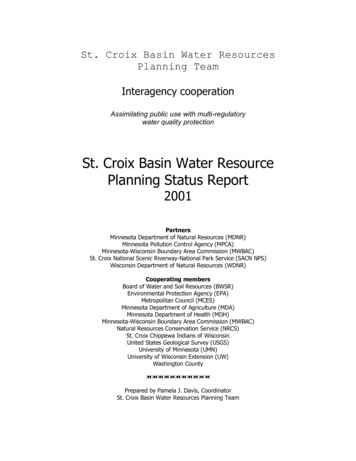
Transcription
St. Croix Basin Water ResourcesPlanning TeamInteragency cooperationAssimilating public use with multi-regulatorywater quality protectionSt. Croix Basin Water ResourcePlanning Status Report2001PartnersMinnesota Department of Natural Resources (MDNR)Minnesota Pollution Control Agency (MPCA)Minnesota-Wisconsin Boundary Area Commission (MWBAC)St. Croix National Scenic Riverway-National Park Service (SACN NPS)Wisconsin Department of Natural Resources (WDNR)Cooperating membersBoard of Water and Soil Resources (BWSR)Environmental Protection Agency (EPA)Metropolitan Council (MCES)Minnesota Department of Agriculture (MDA)Minnesota Department of Health (MDH)Minnesota-Wisconsin Boundary Area Commission (MWBAC)Natural Resources Conservation Service (NRCS)St. Croix Chippewa Indians of WisconsinUnited States Geological Survey (USGS)University of Minnesota (UMN)University of Wisconsin Extension (UW)Washington CountyPrepared by Pamela J. Davis, CoordinatorSt. Croix Basin Water Resources Planning Team
St. Croix Basin Water Resources Planning Status ReportTable of ContentsSt. Croix Basin Water ResourcesPlanning Status Report 2001Table of ContentsAcknowledgements .List of tables .St. Croix Basin map . Executive summary . .Chapter 1: St. Croix Basin Planning and Accomplishments Chapter 2: Setting . Chapter 3: Water Resources Regulations for the St. Croix Basin .Chapter 4: Water Quality .Chapter 5: Issue statements .Issue statement 1: Nutrients .Issue statement 2: Coordinator funding Issue statement 3: Urban stormwater runoff .Issue statement 4: Monitoring program Issue statement 5: Public involvement and stewardship .Issue statement 6: Resolve differences in water qualitystandards between the two states .Issue statement 7: Forecast future land use changesand the impact on water quality .Issue statement 8: Rural non point runoff (other then Nutrients,sediments and stormwater) Issue statement 9: Sediment contamination .Issue statement 10: Impoundments .Issue statement 11: Groundwater .Issue statement 12: Recreational impacts .Issue statement 13: Rare and endangered species .Issue statement 14: Impacts of water-dependentcommercial agricultural operations References iiiiii1152133383944464750Appendix .Appendix 1: Cooperative AgreementAppendix 2: Minnesota Watermarks, St. Croix sectionAppendix 3: Minnesota Pollution Control Phosphorus strategyAppendix 4: “No net increase in nutrients” voluntary programAppendix 5: Guidance for Watershed Stewardship Lower St. CroixRiver: A Stream Protection Strategy*76* (From: Tom Schueler. 1995. Site Planning for Urban Stream Protection.Protection. Ellicott City, Maryland)53555657596163666971Center for WatershedSt. Croix Basin Water Resources Planning Team: Assimilating public use with multi-regulatory water quality protection
St. Croix Basin Water Resources Planning Status ReportList of TablesSt. Croix Basin Water ResourcesPlanning Status Report 2001List of TablesTable Number and NameTable 1: Significant accomplishments of the Basin TeamTable 2: Common goals, objectives and indicators for all major basins in Minnesota fromthe Minnesota Governor’s Unification Initiative as discussed in Minnesota WatermarksPageNumber410Gauging the Flow of Progress 2000 – 2010Table 3: Important Dates in Natural and Cultural History of the St. Croix River: From theLower St. Croix National Scenic Riverway River Stewardship Guide, M-WBAC 1994 andthe North Central Forest Experiment Station Report prepared by Barbara Andersen et al.,in 1995.Table 4. The population for 1999 and % of growth from 1990 to 1999 of countiespartially or wholly in the St. Croix BasinTable 5: Land use trends in the St. Croix BasinTable 6. Wisconsin water use standardsTable 7. Water Use Classifications for MinnesotaTable 8. Minnesota Pollution Control Agency (MPCA) Stream Water Quality AssessmentParametersTable 9. Minnesota Pollution Control Agency Standards for Wastewater TreatmentFacilitiesTable 10. Variables resulting in land use changes and their impact on water qualityTable 11. Nitrate and phosphorus yields in pounds per square mile per year in forest,agriculture, and urban streams, 1996-1998Table 12. Water use, in million gallons per day, in the Upper River Watershed,Wisconsin, which includes reservation landTable 13. Amounts of phosphorus and nitrogen in the St. Croix Basin in tons per yearper square mileTable 14. Results for MCES monitoring from 1976-1996 at PrescottTable 15. Land use by selected tributaries in the St. Croix BasinTable 16. Average per-season use and user estimates, St. Croix River, 1989-1997 vs1999Table 17. Descriptive statistics of fecal coliform and E. Coli concentrations in theNamekagon and St. Croix Rivers, 1999171920272829303334374041426465iiSt. Croix Basin Water Resources Planning Team: Assimilating public use with multi-regulatory water quality protection
St. Croix Basin Water Resources Planning Status ReportExecutive SummarySt. Croix Basin Water Resource Planning Status ReportExecutive SummaryState and federal agencies, nations, and local units of government are working cooperatively toaddress water quality protection and resolve impairments in the St. Croix River Basin. Rapidpopulation growth with the accompanying land use changes is impacting the water resources.The St. Croix Basin Water Resources Planning Status Report (Planning Status Report) is acooperative project among state and federal agencies and the St. Croix Chippewa Indians ofWisconsin. The Planning Status Report describes the history of water resource management inthe St. Croix Basin, examines the water resources of the St. Croix Basin, lists other plansdeveloped for the St. Croix Basin, directs water resource decision making, and provides a vehicleto create a unified plan between the two states of Wisconsin and MinnesotaThe St. Croix Basin Water Resources Planning Team (Basin Team) that oversaw this planningstatus report does not have legislative authority; as such this document was created to direct andfacilitate water resource protection in the St. Croix Basin. The Planning Status Report is intendedfor four uses: a) to direct water resource decision making, b) as a source of information forfunding opportunities, c) as a vehicle to create a unified plan between the two states of Wisconsinand Minnesota, and d) as an internal agency document.Goal of the St. Croix Basin Water Resources Planning Status ReportThe goal of the St Croix Basin Water Resources Planning Status Report is to integrate into one unit a plan to protectand improve the quality of the surface and ground water resources of the St. Croix River Basin in Minnesota,Wisconsin, and Chippewa reservation land through coordinated planning and management.The Planning Status ReportThe Planning Status Report provides background and future direction for decision-making in theSt. Croix Basin. Chapter One, St. Croix Basin Planning and Accomplishments, providesinformation about the Basin Team. Through an interactive decision making process the BasinTeam determined the key issues (Issue Statements) of concern for St. Croix water resourceprotection. Other planning organizations and their activities within the St. Croix Basin are alsodiscussed. Included in Chapter One is a list of the accomplishments of the Basin Team. InChapter Two a physical description offers background material for water resource impacts fromland use changes and habitat modifications. Chapter Three documents the water resourceregulations that affect the St. Croix Basin. Summaries of recent water quality studies in ChapterFour provide a snapshot of the current conditions of the St. Croix Basin. Fourteen IssueStatements, or areas of concern, are discussed in Chapter Five. These Issue Statementsidentify the implementation phase of the Basin Team’s work and are listed in order of priority.Issue Statements (water resource issues) identified by the St. Croix Basin WaterResources Planning Team in Phase I of Plan of Study(revised 6/20/01)1. Establish nutrient budgets for point and nonpoint sources2. Secure funding for the Basin Team coordinator3. Address the impact of urban stormwater runoff4. Address the need for long term monitoring5. Increase public participation and knowledge in water quality management6. Resolve differences in water quality standards between the two states7. Forecast the future changes in land and water resources8. Address the impact of rural nonpoint runoff (other then nutrients, sediment, andstormwater)9. Evaluate sediment contamination10. Assess the impact of impoundmentsiiiSt. Croix Basin Water Resources Planning Team: Assimilating public use with multi-regulatory water quality protection
St. Croix Basin Water Resources Planning Status ReportExecutive Summary11. Assess the condition of the groundwater and suggest a protection strategy, listidentified areas of higher sensitivity12. Assess the impact from recreational use13. Develop a common protection strategy for rare and endangered species and naturalcommunities and their habitat14. Assess the impact of water-dependent commercial agricultural operationsThe appendix offers copies of some of the documents discussed in the Planning Status Report.Integrated Watershed ManagementThe St. Croix River is the resource that encouraged a sense of community and urbandevelopment into the St. Croix Basin. History has shown the importance the river plays in thelives of those who live along the river, its tributaries and within the watershed: those who come torecreate and those who use the river for commerce. The character of river communities, humanand natural, is mirrored in the quality of its water.When our predecessors analyze the ecological health of the St. Croix Basin will we be anexample of vision or simply reactive management? How the growth of the Basin is addressed andmanaged will reflect the priorities of those responsible for the future of this scenic resource.Whether from the impact of invasive species, excessive nutrient loading, or increased recreation,the water resources of the St. Croix are at risk. Through sustainable planning and manageddevelopment, the river can maintain its health and support the uses for which it is valued.As we advance into the twenty-first century, a shift in public attitude towards the environment,technology advances, and developments in ecosystem management support a proactive andpartnership approach to water quality management. Integrated basin management can be themost effective method of addressing conflicts over water use. In integrative watershedmanagement local citizens and organizations cooperatively share in the decision-making processand outcomes. Integrative basin management provides the best opportunity for sustainability ofour water resources while protecting the uses of the river for citizens, organizations, andagencies. Understanding the biophysical and chemical components of water quality incorporatesa rationale behind the decision making process. Supplied with technical and scientific analysis,we need to be able to make informed decisions about managing our natural resources.The St. Croix Basin Water Resources Planning Team is working to assimilate public use andtechnical information with multi-regulatory water quality protection.St. Croix Basin Team Partners: signature agencies in the Memorandum of UnderstandingNational Park Service (SACN, NPS)Minnesota Department of Natural Resources (MNDR)Wisconsin Department of Natural Resources (WDNR)Minnesota Pollution Control Agency (MPCA)Minnesota-Wisconsin Boundary Area Commission (MWBAC)Cooperating membersBoard of Water and Soil Resources (BWSR)Environmental Protection Agency (EPA)Metropolitan Council (MCES)Minnesota Department of Agriculture (MDA)Minnesota Department of Health (MDH)Minnesota-Wisconsin Boundary Area Commission (MWBAC)Natural Resources Conservation Service (NRCS)St. Croix Chippewa Indians of WisconsinUnited States Geological Survey (USGS)University of Minnesota (UMN)University of Wisconsin Extension (UW)Washington CountyivSt. Croix Basin Water Resources Planning Team: Assimilating public use with multi-regulatory water quality protection
St. Croix Basin Water Resources Planning Status ReportChapter 1: St. Croix Basin Planning and AccomplishmentsChapter 1: St. Croix Basin Planning and AccomplishmentsChapter 1.1: St Croix Basin Water Resources Planning Status ReportSt. Croix Basin Water Resources Planning Status Report (Planning Status Report) has fiveobjectives.Objectives of the St. Croix Basin Water Resources Planning Status ReportDescribe the history of water resource management in the St. Croix BasinExamine the water resources of the St. Croix Basin and water quality concernsReview other plans developed for the St. Croix River corridorDirect water resource decision making5) Provide a vehicle to create a unified plan between the two states of Wisconsin and Minnesota1)2)3)4)Chapter 1.2: St. Croix Basin Water Resources Planning TeamIn the early 1990s continued development and usage of the St. Croix River concerned waterresource managers about the impact on water quality. For example, research providedsupporting evidence that nutrient loading from the tributaries was increasing the rate ofeutrophication in Lake St. Croix, a sink of the St. Croix River Basin. Although the St. Croix Riverwas protected as a National Park, the federal government had no control over the quality of thewater flowing into the park. State and federal governments would need to work together toprotect the St. Croix Basin from recreational and land use impacts. In 1993, a cooperativeagreement was signed by the National Park Service, the Minnesota Department of NaturalResources, the Wisconsin Department of Natural Resources, and the Minnesota Pollution ControlAgency. The Cooperative Agreement states (see Appendix 1 for complete copy):I.A St. Croix Basin Water Resources Planning Team (Basin Team) shall be formedto bring together periodically the parties responsible for the formulation andimplementation of a joint basin water resource management plan.II.The membership shall consist of an appointed representative from the NationalPark Service; two representatives from the State of Minnesota, including onefrom the Department of Natural Resources (MDNR) and one from the MinnesotaPollution Control Agency (MPCA); and two representatives from the State ofWisconsin Department of Natural Resources (WDNR), including one from each ofthe two districts comprising Wisconsin’s portion of the St. Croix River Basin.These agencies are the signature groups of the Cooperative Agreementdetermined by the Memorandum of Understanding. The MDNR, WDNR, MPCAand NPS regulate policy in the St. Croix Basin.III.The Minnesota-Wisconsin Boundary Area Commission (MWBAC) shall act as afacilitator of the joint planning effort for the St. Croix River Basin team, withinthe funds and staff resources available to it. (Editor’s note: In the fall of 2001,the Wisconsin legislature ended a 36-year interstate compact between Wisconsinand Minnesota and shut down the MWBAC.)IV.The objective of this Basin Team shall beA. To formulate a consolidated and uniform plan for the St. Croix River Basincovering the respective jurisdictions of the parties to this agreement with1St. Croix Basin Water Resources Planning Team: Assimilating public use with multi-regulatory water quality protection
St. Croix Basin Water Resources Planning Status ReportB.C.D.E.F.Chapter 1: St. Croix Basin Planning and Accomplishmentsrespect to identifying, monitoring and controlling adverse threats andimpacts to the quality of the waters of the basin;To cooperate fully with the U.S. Geological Survey in the design andimplementation of the National Water Quality Assessment Program UpperMississippi River study as it relates to the St. Croix River Basin;To develop a Plan of Study for a basin plan by September of 1993 andformulate a completed plan by June of 1995 [these dates have subsequentlybeen revised for a Basin Planning Status Report, instead of a Basin Plan, tobe completed by August 30,2001];To coordinate implementation of said monitoring and measures on a prioritywatershed basis within the basin;To act as a forum for local government and public involvement in basinwater quality management planning; andTo periodically review and update said plan.From this Cooperative Agreement (Memorandum of Understanding) the St. Croix Basin WaterResources Planning Team was created to oversee the development of a basin plan and act as aforum for interagency interaction and local government and public involvement.The original Basin Team has grown to include numerous interested organizations in varying levelsof participation.Organizations of the St. Croix BasinWater Resources Planning TeamSignatory Agencies in Memorandum of UnderstandingMinnesota Department of Natural Resources (MDNR)Minnesota Pollution Control Agency (MPCA)Minnesota-Wisconsin Boundary Area Commission (MWBAC)National Park Service (NPS)Wisconsin Department of Natural Resources (WDNR)Cooperating MembersBoard of Water and Soil Resources (BWSR)Environmental Protection Agency (EPA)Metropolitan Council Environmental Services (MCES)Minnesota Department of Agriculture (MDA)Minnesota Department of Health (MDH)Natural Resources Conservation Service (NRCS)St. Croix Chippewa Indians of WisconsinUnited States Geological Survey (USGS)University of Minnesota (UMN)University of Wisconsin Extension (UWExt)Washington CountyThe Basin Team has four goals: Goals of the St. Croix Basin Water Resources Planning TeamProtect and improve the quality of the surface and groundwater resources of the St. Croix.Provide a forum for water resources managers to integrate local, state, and federal policy.Increase public participation and knowledge in water quality management.Project development and implementation.2St. Croix Basin Water Resources Planning Team: Assimilating public use with multi-regulatory water quality protection
St. Croix Basin Water Resources Planning Status ReportChapter 1: St. Croix Basin Planning and AccomplishmentsThe Basin Team gathered in 1994 to develop water resource goals and a plan to accomplishthese goals. The plan was divided into four phases.Phase I: Plan of Study - In this phase, co-managers of water resources organized intoa St. Croix Basin Team. Through a scoping session key surface and groundwater issueswere identified and thus formed the basis upon which to direct the Basin Team’sactivities. These issues are addressed as Issue Statements in Chapter 5.0 of the BasinPlanning Status Report. Phase I was completed in December of 1993 as a foundation forPhase II. The original issues were recently reviewed and ranked in order of importance(6/20/01) for the Basin Team to address.* Issue Statements (water resource issues) identified by the St. Croix Updated Ranking6/20/01Basin Water Resources Planning Team in Phase I of Plan of Study(revised 6/20/01)1. Establish nutrient budgets for point and nonpoint sources2. Secure funding for the Basin Team coordinator3. Address the impact of urban stormwater runoff4. Address the need for long term monitoring5. Increase public participation and knowledge in water quality management6. Resolve differences in water quality standards between the two states7. Forecast the future changes in land and water resources8. Address the impact of rural nonpoint runoff (other then nutrients, sediment, andstormwater)9. Evaluate sediment contamination10. Assess the impact of impoundments11. Assess the condition of the groundwater and suggest a protection strategy; listidentified areas of higher sensitivity12. Assess the impact from recreational use13. Develop a common protection strategy for rare and endangered species and naturalcommunities and their habitat14. Assess the impact of water-dependent commercial agricultural operations1122234567891011*Notes to above listing of issue statements Initial item from Phase I: Develop a GIS information base to track land use changes; Noranking necessary; issue resolved Initial item from Phase I:Coordinate fish consumption advisories; No ranking necessary; issueresolved. New item suggested June 2001: Identify and establish goals that reflect public perceptionsand intentions; determine and develop a means to measure baselines for these goals andprogress towards them; develop an annual report card (Ranked 2 by those whorecommended this item).Phase II: Data Acquisition for Setting Goals - In this phase, a draft plan wascreated describing a list of environmental studies necessary to research the waterresource issues (Issue Statements) identified through the scoping session. These studieswere necessary to determine priority waterways and set water quality goals for theBasin. The plan also identified the agencies that will conduct the studies, the fundsneeded, and the approximate timelines (generally within two years). The Phase IIdocument was completed in 1995 and is incorporated in the Planning Status Report.Environmental studies are ongoing. The studies discussed in the Planning Status Reportare not meant to be an inclusive list of all the research completed or in progress in theSt. Croix Basin. This list includes those projects targeted towards the issues addressed bythe Basin Team.3St. Croix Basin Water Resources Planning Team: Assimilating public use with multi-regulatory water quality protection
St. Croix Basin Water Resources Planning Status ReportChapter 1: St. Croix Basin Planning and AccomplishmentsPhase III: Setting Objective to Reach Goals - In this phase, water quality goals willbe developed using the information obtained in Phase II. Examples of such goals mightbe: (1) How much phosphorus reduction is needed to protect Lake St. Croix; or (2) Howmuch mercury reduction is needed and over what timeline to eliminate fish consumptionadvisories in the St. Croix River. Phase III is in process. A nutrient budget for the St.Croix Basin is discussed in Chapter 5.0, Issue Statement 1: Nutrients.Phase IV: Project Development and Implementation - In this phase, specificprojects will be developed and implemented as resources are available. Interagencypartnerships with local governmental units will be used to focus financial resources andexpertise on the issues of concern. It is hoped that a number of local projects can bestrategically sequenced and integrated so that small successes can aggregate into anoverall resolution of the environmental issues that need to be addressed. Phase IV is inprocess and incorporated into the Issue Statements in this plan.Biennial Reviews - Work plans will be developed on a biennial timeline with theintention of involving the public in reviewing progress, updating the plan and redirectingresources as appropriate to address current issues. The work plans will serve asacknowledgments of commitments from the participating agencies. Issue statements willbe reviewed every two years by the Basin Team.State Basin Plans - Each state has its own basin planning process, which recognizesthat waterways within the Basin have intrinsic values within the state where they exist.Waterways identified as having impacts on the main stem of the St. Croix River willreceive priority attention, but not to the exclusion of more localized activities on each ofthe tributaries and lakes within (see Other Planning Efforts following this section).Table 1 identifies the significant accomplishments of the Basin Team since its inception in1993. Total project dollars contributed to the study of the St. Croix since 1994 that canbe directly or indirectly attributed to the Basin Team's efforts exceed 1,384,600. Thisdoes not include the freshwater mussel conservation efforts, exotics control programs,the NAWQA program, or the salary for the involvement of the Basin Team members.Table 1. Significant accomplishments of the Basin Team.Accomplishments of the St. Croix Basin Water Resources Planning Team1993-2001Prepared by Randy Ferrin, Chair, St. Croix Basin Water Resources Planning Team, July 13, 2001 1993Memorandum of Understanding signed between the Secretary, Wisconsin Department ofNatural Resources (WDNR), the Commissioner, Minnesota Department of Natural Resources(MDNR), the Commissioner, Minnesota Pollution Control Agency (MPCA), and theSuperintendent, St. Croix National Scenic Riverway (National Park Service), with facilitationfrom the Minnesota-Wisconsin Boundary Area Commission (MWBAC).1994Basin Team convinces the U.S. Geological Survey (USGS) to include the St. Croix andNamekagon Rivers in its Upper Mississippi River National Water Quality Assessment Program(NAWQA). This proves to be major success for the Team and sets the stage for many of theadditional studies and monitoring, which will occur over the next several years. Numerousreports have been published by the USGS highlighting the results of the NAWQA work in theUpper Mississippi and St. Croix Basins.4St. Croix Basin Water Resources Planning Team: Assimilating public use with multi-regulatory water quality protection
St. Croix Basin Water Resources Planning Status ReportChapter 1: St. Croix Basin Planning and Accomplishments USGS becomes a cooperating partner on the Basin Team. WDNR releases its St. Croix Basin Water Quality Management Plan with tributary specificrecommendations for water quality protection. National Park Service-St. Croix National Scenic Riverway (NPS) hires its first water resourcesspecialist who will also serve as the chief of the Riverway's natural resources division,answering directly to the Superintendent. Justification for the position includes directinvolvement with the Basin Team. NPS begins its own water resources plan as required by the NPS Washington Office-WaterResources Division (NPS-WRD). Funding ( 50,000) is received from the NPS-WRD and theUniversity of Minnesota (UM) is awarded the contract. The planning process involves theBasin Team in issue identification and prioritization, identifying sources of data andinformation, draft review, suggestions, and endorsement. UM becomes a cooperating partner on the Basin Team. 1995After a major issue-identification effort, with MOU and non-MOU partners participating, theBasin Team releases Phase II of its planning effort in which several dozen issues are identifiedand discussed and recommendations for action are made. Secretary Meyer, WDNR,Commissioner Sando, MDNR, Commissioner Williams, MPCA, and NPS-RiverwaySuperintendent Andersen send letters of endorsement and commitment. Phase II sets thestage for the formation of several subcommittees charged with resolution of the identifiedissue. This includes the nutrient issue, recreational affects issue, GIS coordination, standardscoordination, and other efforts. Under the leadership of the MWBAC, the Lower St. Croix Management Commission, and theBasin Team, and based on a coordinated interagency report on the adequacy of pump-outfacilities and enforcement, WDNR Secretary Meyer and MPCA Commissioner Williams jointlypetition EPA to declare the St. Croix as off-limits for boat sanitary waste discharges. EPAaccepts the petition and changes the discharge rule. Interagency study lead by MDNR begins to investigate the impacts of recreation and boatingon island erosion in the lower river, an issue identified by the Basin Team. Results from thestudy are published in 2001 and include 10 chapters describing 10 distinct components of thestudy. The NPS and MDNR provide funding for printing. Long-term components of the studycontinue with annual surveys at fixed station erosion study sites on 12 islands. Contributedtime by all of the agencies to the study is roughly estimated at two-person years. NPS leverages the above study's interagency involvement to secure a 5000 challenge-costshare grant from the NPS CCS program. The money is used to buy a new Hydrolab multiprobe water quality meter. USGS installs gauging station on the Namekagon River as part of the NAWQA program. NPSco-funds the site through 2001. 1996In an effort to address one of the issues identified by the Basin Team, NPS secures 50,000(NPS-WRD) to conduct an aquatic habitat assessment and classification for the Riverway. UMconducts the study. The Basin Team's partnership efforts are highlighted in the proposal andthe proposal gains extra review points because of this partnership. The report is released in1999 and is titled: Assessment and Classification of Aquatic Habitat in the St. Croix NationalScenic Riverway.WDNR drops funding for the Danbury USGS gage on the St. Croix. NPS assumes funding forthe next four years, matched by USGS funding.5St. Croix Basin Water Resources Planning Team: Assimilating public use with multi-regulatory water quality protection
St. Croix Basin Water Resources Planning Status ReportChapter 1: St. Croix Basin Planning and Accomplishments Metropolitan Council-Environmental Services becomes a cooperating partner on the BasinTeam. Following up on an issue identified by the Basin Team, the NPS secures 50,000 funding (NPSWRD) to evaluate the impacts of cranberry operations on the Namekagon and St. Croix Rivers.USGS Biological Resources Division conducts the study. (The Basin Team's partnership effortsare highlighted in the proposal and the proposal gains extra review points because of thispartnership.) The report is issued in 1999 and is titled: The Effects of Cranberry Operations onWater Quality, Macroinvertebrate Communities, and Pesticide Concentrations of the St. CroixNational Scenic Riverway. With the support of t
St. Croix Basin Water Resources Planning Team Interagency cooperation Assimilating public use with multi-regulatory water quality protection St. Croix Basin Water Resource Planning Status Report 2001 Partners Minnesota Department of Natural Resources (MDNR) Minnesota Pollution Control Agency (MPCA) Minnesota-Wisconsin Boundary Area Commission (MWBAC) St. Croix National Scenic Riverway-National .
